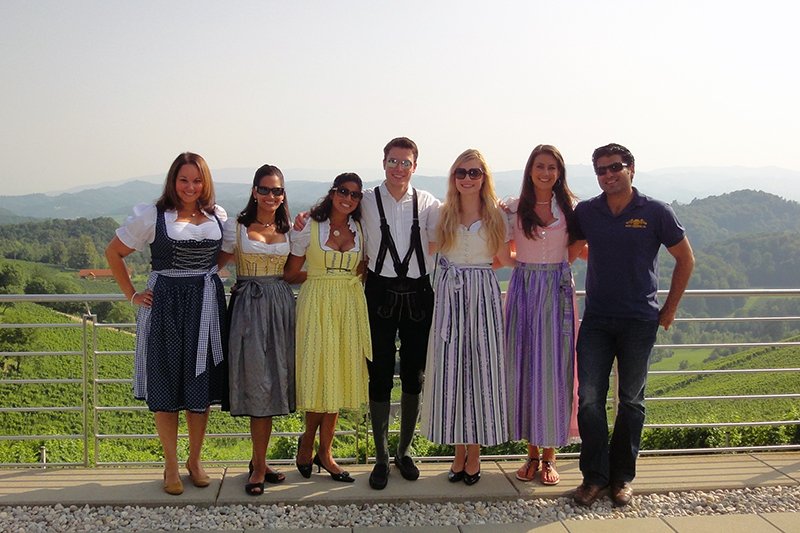This week, the news of a young American girl from Utah wearing a qipao (traditional Chinese dress) was trending. Many people protested that it was “cultural appropriation.” All I saw was a young girl tastefully wearing a dress that although it was not part of her culture, it fit her well. My friend M who is Chinese said about the incident: “for someone to appreciate the beauty in an article of clothing and wear it respectfully is a beautiful thing.” I completely agree.
The scenario made me reflect on my travels and the times I have embraced other’s traditional dress. When I read the comments, for and against on Twitter, I began to go back in time. My memories of wearing traditional attire go from Thailand to Senegal to Germany. In no way was I trying to appropriate someone else’s culture. On the contrary, I was trying to learn more about it.

Fifteen years ago, I was stationed in Japan. It was my first time living abroad. It was a place that opened my mind and palate to the world. During my time in Asia, I got to spend almost two months working in Thailand. I lived and worked at a Royal Thai military base. I fell in love with papaya salad, Mekong whiskey and coke, and most of all, with the Thai people. The opportunity came to take a photo dressed in traditional Thai attire, and I jumped at it. The lovely Thai ladies dressed me in traditional dress, a Sihn with elaborate accessories and a massive golden headdress. I recall all sweet compliments they gave me, an American Puerto Rican girl wearing their national attire.
I had the photo printed and it sits in my mom’s living room. It’s always a point of conversation. I wonder if I would’ve been burned at the social media stake if I would’ve attempted to post something like my outfit on social media today. The experience was so much fun in 2003 that when I returned to Thailand in 2007, I had another photo session.

Back in 2007, I was working in Senegal on a military humanitarian mission. After a month in the field, living in an abandoned school and taking “showers” with water bottles, I was invited to the US Ambassador’s 4th of July party. I didn’t get the memo that I needed a formal outfit. I had no appropriate civilian attire. I wasn’t going to give up a party with open bar and buffet after a month of roughing it out because I had nothing to wear. One of my Senegalese counterparts suggested I get a Bazin, a traditional West African dress.
I remember going to the boutique at the hotel and asking the ladies at the shop to help me pick a dress. They had a ball dressing me up, making me try on every dress in my size. I ended up with a beautiful white and gold Bazin that I also wore during a business trip to Ghana to the delight of my local colleagues. I believe it also showed my coworkers that I was open to learning about their culture. I was told by many that it was an honor to see me wearing their traditional dress.
It also made me feel closer to my African ancestors. Being in Africa was a defining moment for me as African roots is a big part of our Puerto Rican culture. To be able to wear the Bazin and be accepted was a great moment for me.

In 2006, my best friend R got married in a traditional Indian ceremony. Her mother gave us Saris and Lengas, both traditional Indian attire as part of our wedding party outfits. A lot of people think I am Indian so it almost felt natural to wear one! A Sari is such a beautiful dress, so rich in history, and I was honored that her mom allowed us to wear these uniquely gorgeous dresses.

I remember going to Oktoberfest for the first time in 2006. I remember how left out I felt in these massive tents with everyone dressed in their dirndls and lederhosen. I saw people from every race: Asian, Black, Hispanic, wearing German attire. A few years later, I was back at Oktoberfest. My friend Ronny who’s Bavarian told my friend and I: “If you’re going to do Oktoberfest, you have to do it right. We need to get you dirndls”.

He took us to a high-end departmentnt store and we splurged in beautiful dirndls that I still own today. The German lady at the store cheerfully helped us find the right size and look. She took her time finding the perfect look for us. I would say we were at the shop for over two hours picking our outfits. The following day we went to Oktoberfest and received tons of compliments on our dirndls. Now I own four! After many years of going to Germany and Austria, I cannot resist the temptation to buy more! They are gorgeous.
What sets me off at an Oktoberfest is when someone wears a costume fake dirndl or lederhosen. These outfits, like the others mentioned before, have been part of a culture for centuries. If you cannot afford a proper dirndl or lederhosen, just wear a regular outfit. To me, that’s when it becomes disrespectful.
To me, wearing a dress from another culture can be a learning experience. I’ve learned so much from the fittings and talking to the people who are lending or selling me the attire. I look back at all my experiences with lengas, bazins, dirndls and other dresses and what I remember the most is all the things I learned from the experience. Most importantly, I engaged with the locals and asked about local customs and how to appropriately wear the outfits.








